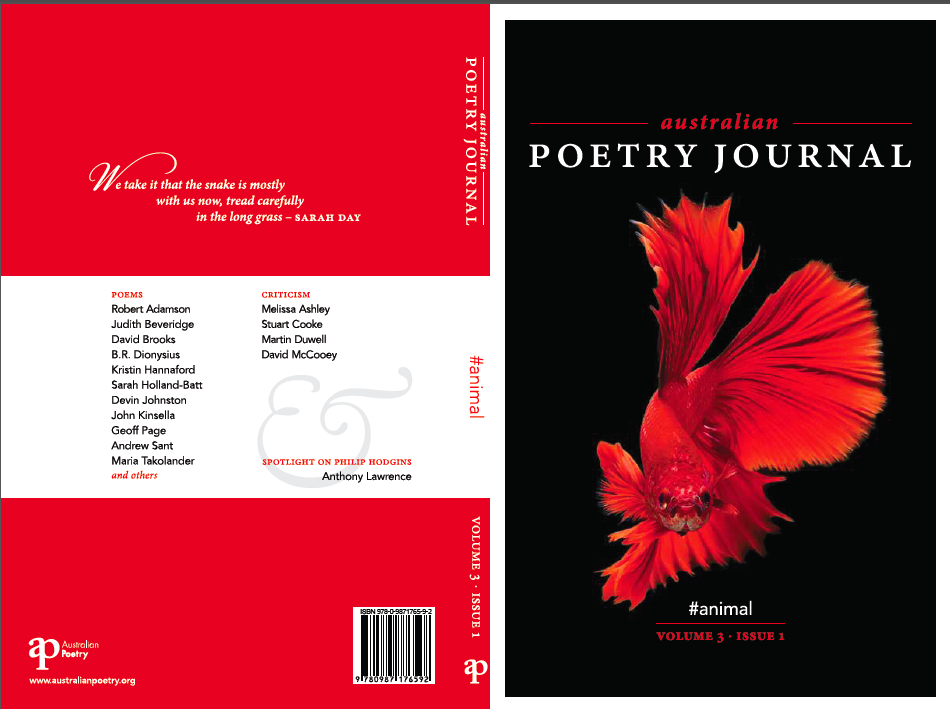 Humans may prefer to distinguish themselves from all other multiccellular, eukaryotic organisms but ‘humans’ live only in the philosopher’s imagination. In the minds of biologists we are Homo sapiens of Kingdom Animalia. Questions of nomenclature notwithstanding, the human relationship to animals is under the microscope in the #animal issue of Australian Poetry Journal.
Humans may prefer to distinguish themselves from all other multiccellular, eukaryotic organisms but ‘humans’ live only in the philosopher’s imagination. In the minds of biologists we are Homo sapiens of Kingdom Animalia. Questions of nomenclature notwithstanding, the human relationship to animals is under the microscope in the #animal issue of Australian Poetry Journal.
In addition to the myriad roles animals perform in human societies – as companions and workers, as food and objects of sacrifice – animals serve in the human imagination as harbingers of traits we aspire to achieve: football teams, as John Kinsella points out in his poem ‘Zoo’, are called ‘The Falcons, The Eagles, The Seagulls, The Tigers, The Lions, The Kangaroos’. In Judith Beveridge’s poem, ‘Back in the Monastery’, a speaker prays to the dark goddesses, Elephant-Face and Lion-Face, who sit at the threshold of time; and in Ron Pretty’s poem on Marco Polo’s first encounter with a unicorn – ‘or so / he called’ the rhinoceros – ‘myth segues into armour-plated gut’.
Horses run through many poems: sometimes as machinery – ‘a workhorse in a dark field’ in Todd Turner’s ‘Bonsai Wattle’ – or as instruments of war. Waterborne horses are ‘backed against bad weather’ in Angela Gardner’s ‘Ilium’ and horseborne Carbineers ride through Geoff Page’s ‘Marginalia’. But who’d have guessed that goats would dominate a selection of contemporary poems? Among various appearances, mountain goats climb cemented rocks to look down ‘on over-excited human children with disdain’ – again, Kinsella’s poem – and in Kristin Hannaford’s ‘Elegy for Lost Goats’ a nineteenth-century Inspector of Nuisances slits the throats of 400 feral goats to use as fertiliser in the Rockhampton Botanic Gardens.
Less noble perhaps yet no less common, invertebrates abound: the ‘orange domes’ of jellyfish sail through Robert Adamson’s ‘Sugarloaf Bay’, and a bluebottle trawls its tentacles through ‘streets of coral’ in Pretty’s ‘Kiss’. Stephen Edgar’s rhyming couplets materialise ‘the silver scripture of the snail’, and David Brooks’s ode to garden slugs – ‘young, just-antlered elk / crossing fresh-fallen snow / leaving their silver trails’ – raises the ethics of the human-animal relations. Prior to a conversion that would see the speaker coax slugs onto lettuce leaves and deliver them into the long grass, he would have sprinkled them with salt.
Strong identification with an animal, particularly if you intend to eat it, does not lead to an easy conscience. Dark humour is David McCooey’s way out: ‘what will cure him’, he wonders in ‘Sandwich Meat’, of his taste for ‘thinly sliced animals’. But the animal bites back: a dark fin cuts a pathway to civilisation; a black snake brings complexity to the woodstack. In her poem ‘Inheritance’ Maria Takolander ratchets up the primal fear of being eaten when an old man tells the speaker that her father has been eaten by pigs. ‘Only some bones and rags were left.’
Few poets, Adamson included, can avert their eyes from the spectacle of birds: macaws ‘flaring with reds / and blues’ take centre stage as the white haze lifts. ‘The slow peel of apple skin under a prized chef ’s steady hand’ is how B.R. Dionysius describes six wedge-tailed eagles riding a thermal to an immovable feast. ‘Syrinx’ by American poet Devin Johnston is an ode to the vocal organs of birds, while in ‘Ameraucana’ all praise goes to the hen who lays ‘a perfect form of incompletion: [the] first egg of the year’.
Zooming from microcosms to cosmologies, Melissa Ashley reviews John Kinsella’s Jam Tree Gully and M.T.C. Cronin’s The World Last Night. McCooey frames the human animal in Jennifer Maiden’s Liquid Nitrogen and finds Amy Brown’s The Odour of Sanctity populated by saints, among them Rumwold of Buckingham – a Medieval baby who lived for three days and spoke like an adult. In his review of The Cambridge Companion to American Poetry Since 1945, edited by Jennifer Ashton, Martin Duwell stares down ‘the strange beast’ of postwar American poetry, while Anthony Lawrence shines a ‘Spotlight’ on Australia’s much-loved Philip Hodgins, whose poetic imagination was formed under the intense emotional pressure of being diagnosed with leukaemia at the age of 24. Meanwhile, high in the Andes, in a small town called Uspallata, Stuart Cooke considers the fates of felines, big and small, in his ecopoetic essay, ‘A Poetics of Strays’. Elsewhere in this mad menagerie a cat named Caesar philosophises in Burmese and dreams you into the afterlife.



